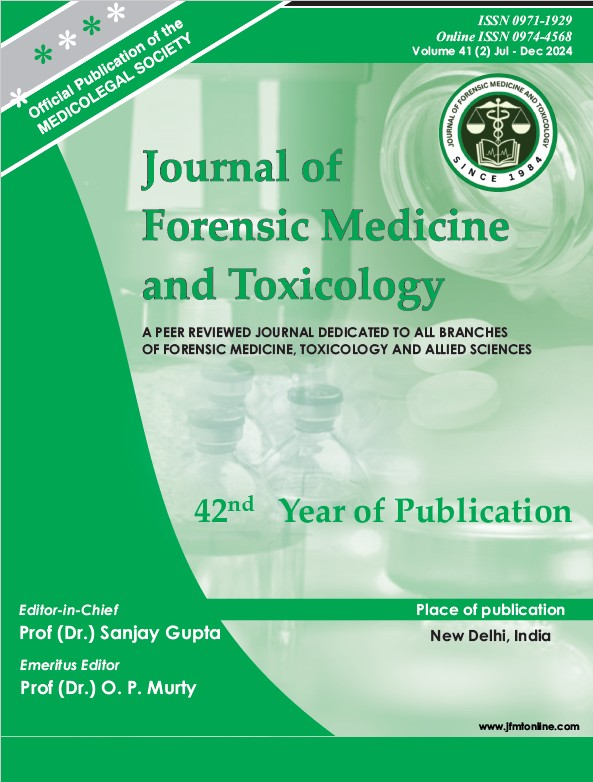A Comparative autopsy-based study of presence of fluid in paranasal sinuses in deaths due to drowning and other asphyxial deaths in North Kerala
DOI:
https://doi.org/10.48165/jfmt.2025.42.3.13Keywords:
drowning, autopsy, paranasal sinuses, Svechnikov’s sign.Abstract
Background: Drowning is regarded as the primary cause of fatalities in aquatic environments and the third most prevalent form of accidental death globally, with the largest incidence rates occurring in underdeveloped nations. Accurate forensic diagnosis of drowning poses a problem because of the generic characteristics of post-mortem findings derived from traditional autopsy techniques. This study examines the importance of fluid in the paranasal sinuses in drowning incidents and aims to differentiate drowning from non-drowning instances. Methods: This was an observational descriptive comparative study done in fifty cases of drowning fatalities and fifty cases of other asphyxial fatalities who underwent medicolegal autopsy at the Department of Forensic Medicine, Government Medical College, Kannur. The paranasal sinuses were inspected for fluid during the medicolegal autopsy. Results: The study group consisted primarily of males (62.7%) with an average age of 46.90±16.34 years. Nearly half of them were in their fourth and fifth decades of life. In this study, 46 (92%) of the 50 drowning cases exhibited fluid in the paranasal sinuses (frontal, maxillary and sphenoid sinuses). None of the 50 instanc es of other asphyxial deaths showed fluid in the paranasal sinuses. The findings endorse the efficacy of para nasal sinus fluid analysis as a significant diagnostic tool in instances where drowning is suspected yet cannot be conclusively verified by conventional methods. Conclusion: This study demonstrated that the presence of fluid in the paranasal sinuses serves as a diagnostic indi cator of drowning-related death, corroborating other research. The physiological comprehension of fluid accumu lation in the paranasal sinuses of drowning victims and its forensic ramifications illustrate the importance of this diagnostic technique in medico-legal enquiries. The detection of fluid in these sinuses offers insights into the phys iopathology of drowning and serves as a crucial instrument for distinguishing between drowning and non-drown ing incidents, thus facilitating the precise identification of the cause of death and assisting in criminal enquiries.
Downloads
References
Morris NK, Du Toit-Prinsloo L, Saayman G. Drowning in Pretoria, South Africa: a 10-year review. J Forensic Leg Med. 2016;37:66–70.
Saberi Anary SH, Sheikhazadi A, Ghadyani MH. Epidemiology of drowning in Mazandaran Province, North of Iran. Am J Forensic Med Pathol. 2010;31(3):236–242.
World Health Organization. Global report on drowning [Internet]. Geneva: World Health Organization; 2014 [cited 2025 Sep 18]. Available from: https://www.who.int/publications/i/item/global-report-on-drowning
Layon AJ, Modell JH. Drowning: update 2009. Anesthesiology. 2009;110(6):1390–1401.
Keil W. Tod im Wasser. In: Madea B, editor. Rechtsmedizin. 3rd ed. Berlin: Springer; 2015. p.288–297.
Püschel K. Problemfall „Wasserleiche“/Ertrinken. Unfall, Suizid, natürlicher Tod oder Tötungsdelikt? Kriminalistik. 2007;61:545–550.
Lawler W. Bodies recovered from water: a personal approach and consideration of difficulties. J Clin Pathol. 1992;45(8):654–659.
Dolinak D, Matshes EW, Lew EO. Forensic pathology: principles and practice. 1st ed. Burlington: Elsevier Academic Press; 2005.
Raux C, et al. Diagnosis of drowning using post-mortem computed tomography–state of the art. Arch Med Sadowej Kryminol. 2014;64(3):144–152.
Hottmar P. Detection of fluid in paranasal sinuses as a possible diagnostic sign of death by drowning. Arch Kriminol. 1996 Sep–Oct;198(5–6):161–169.
Muthumuneeswaran R. A study of presence of fluid in paranasal sinuses (frontal, maxillary and sphenoid) in cases of death due to drowning in comparison with other causes of death subjected to autopsy at Tirunelveli Medical College [master’s thesis on the Internet]. Tirunelveli: Tirunelveli Medical College; 2020 [cited 2022 Mar 8]. Available from: http://example-link
Unnithan S, et al. Fluid in sphenoidal sinus in cases of drowning. Int J Toxicol Pharmacol Res. 2023;13(2):98–106.
Tanaka N, Kinoshita H, Jamal M, Takakura A, Kumihashi M, Miyatake N, et al. Detection of chlorine and bromine in free liquid from the sphenoid sinus as an indicator of seawater drowning. Leg Med (Tokyo). 2015;17(5):299–303.
Lee S, Ryu K. The significance of fluid in the sphenoid sinuses in death by drowning. Korean J Leg Med. 2013;37(3):129–134.
Kawasumi Y, Kawabata T, Sugai Y, Usui A, Hosokai Y, Sato M, et al. Assessment of the relationship between drowning and fluid accumulation in the paranasal sinuses on post-mortem computed tomography. Eur J Radiol. 2012;81(12):3953–3955.




